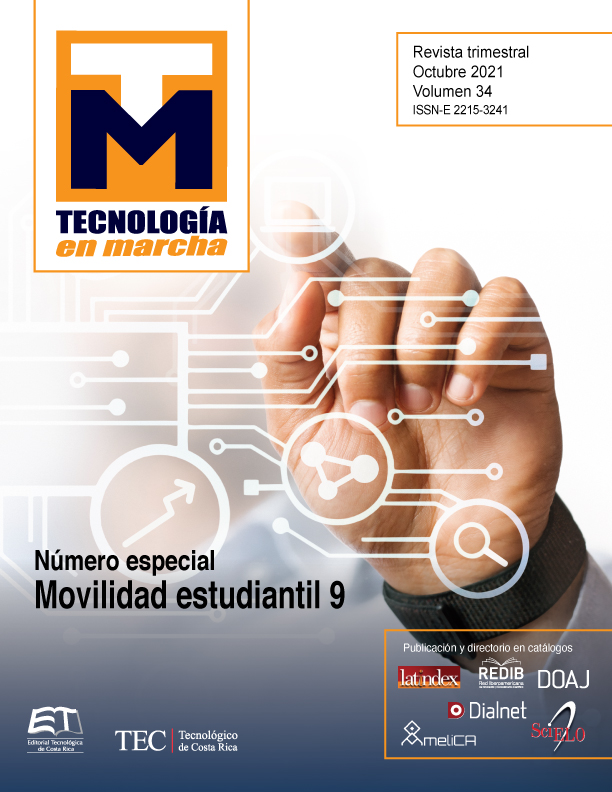Grounded glass as a sustainable technology in hydraulic concrete
Main Article Content
Abstract
Hydraulic concrete is considered as the most consumed human-made resource; however, its elaboration implies a direct and indirect environment pollution. The hydraulic cement is one of the principal components of hydraulic concrete, which, besides to be the most expensive element of hydraulic concrete, is also the one that causes the greatest contamination in its manufacture, emitting a high amount of CO2. This article discloses some of the characteristics and benefits of using ground glass as a partial substitute for cement in hydraulic concrete, being this a promising proposal to bring the world of construction closer to sustainability. Researchers around the world have been in charge of seeking the optimization of the concrete mix considering the variables that are linked to it. Those investigations have obtained positive results, showing that this proposal implies not only environmental, but also mechanical and economic advantages.
Article Details

This work is licensed under a Creative Commons Attribution-NonCommercial-NoDerivatives 4.0 International License.
Los autores conservan los derechos de autor y ceden a la revista el derecho de la primera publicación y pueda editarlo, reproducirlo, distribuirlo, exhibirlo y comunicarlo en el país y en el extranjero mediante medios impresos y electrónicos. Asimismo, asumen el compromiso sobre cualquier litigio o reclamación relacionada con derechos de propiedad intelectual, exonerando de responsabilidad a la Editorial Tecnológica de Costa Rica. Además, se establece que los autores pueden realizar otros acuerdos contractuales independientes y adicionales para la distribución no exclusiva de la versión del artículo publicado en esta revista (p. ej., incluirlo en un repositorio institucional o publicarlo en un libro) siempre que indiquen claramente que el trabajo se publicó por primera vez en esta revista.
References
J. Cabezas, L. Zamora. (2019). RECICLAJE DE ENVASES DE VIDRIO. [Online] Recuperado de: http://www.
csj.gob.sv/ambiente/images/RECICLAJE_ENVASES_VIDRIO.pdf
Portland Cement Association. (2004). Diseño y control de mezclas de concreto. México: PCA, 456p.
INTECO. (2015). Construcción. Cemento hidráulico. Especificaciones y Requisitos.
Universidad Nacional de Colombia. (17 de septiembre de 2015). Reducir el impacto ambiental en la producción de cemento. [Online] Recuperado de: https://minas.medellin.unal.edu.co/noticias/facultad/396-reducir-elimpacto-ambiental-en-la-produccion-de-cemento
R. L. Cuevas Kauffmann. (2017). Concreto [Diapositivas de Power Point]
Global Cement and Concrete Association. (2020). Página principal. Obtenido de: https://gccassociation.org
J. Payá. (2012). La “transmutación” sostenible de los residuos para nuevas materias primas en el ámbito del concreto. [Online] Recuperado de: https://riunet.upv.es/bitstream/handle/10251/50095/Paya%20-%20La%20 %22trasnmutacion%22%20sostenible%20de%20los%20residuos%20para%20nuevas%20materias%20 primas%20en%20el%20ámbito%20del....pdf?sequence=1&isAllowed=y
C. GAEDICKE et al. (2015). Effect of recycled materials and compaction methods on the mechanical properties and solar reflectance index of pervious concrete. Revista Ingeniería de Construcción, v. 30, n. 3, p. 159167. Obtenido de: https://scielo.conicyt.cl/pdf/ric/v30n3/en_art01.pdf
J. M. Bosi (2020). PROPOSIÇÃO DE MÉTODO DE DOSAGEM DE CONCRETO PERMEÁVEL COM INCORPORAÇÃO DE RESÍDUOS FINAMENTE COMINUÍDOS. FURB, Blumenau, Brasil.
H. A. IBRAHIM et al. (2016). Effect of palm oil clinker incorporation on properties of pervious concrete. Construction and Building Materials, v. 115, p. 70-77. Obtenido de: https://www.researchgate.net/publication/301246618_Effect_of_palm_oil_clinker_incorporation_on_properties_of_pervious_concrete
A. Bernardo et al. (2018). Concreto permeável com cinza de casca de arroz residual Permeable concrete with residual rice hull ash. Obtenido de: https://www.researchgate.net/publication/330088875_Concreto_permeavel_com_cinza_de_casca_de_arroz_residual_Permeable_concrete_with_residual_rice_hull_ash
P. Martínez (marzo de 2020). Comportamiento físico y mecánico de elementos no estructurales a base de concreto elaborado con fibra de cáscara de arroz. Tecnológico de Costa Rica.
V. Flores (n.d.). RECICLAJE DE VIDRIO. [Online] Recuperado de: https://www.academia.edu/7165632/ RECICLAJE_DE_VIDRIO
J. Garza. (14 de agosto de 2019). Costa Rica es el segundo país de Centroamérica que más vidrio recupera y recicla. La Republica.
M. C. BIGNOZZI. (2015). Glass waste as supplementary cementing materials: The effects of glass chemical composition. Cement and Concrete Composites, v. 55, p. 45-52.
L. N. P. CORINALDESI. (2005). Reuse of ground waste glass as aggregate for mortars. Waste Management, v. 25, n. 2, p. 197-201.
Y. SHAO. (2000). Studies on concrete containing ground waste glass. Cement and Concrete Research, v. 30, n. 1, p. 91-100.
L. M. FEDERICO et al. (2009) Waste of glass as a supplementary cementitious material in concrete-critical review of treatment methods, Cement and Concrete Composites, v. 31, n. 8, p. 606-610.
Y. JANI et al. (2014). Waste glass in the production of cement and concrete–A review. Journal of Environmental Chemical Engineering, v. 2, n. 3, p. 1767-1775.
A. KHMIRI et al. (2013). Chemical behavior of ground waste glass when used as partial cement replacement in mortars. Construction and Building Materials, v. 44, p. 74-80.

